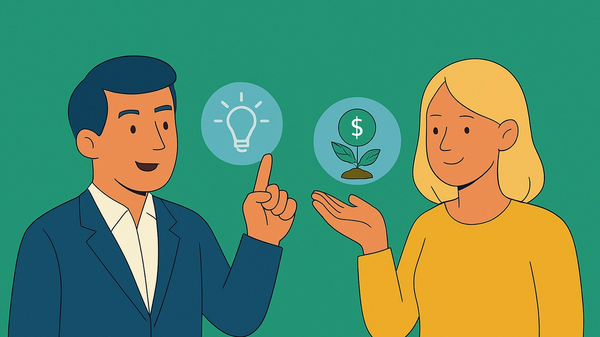Highlights
- How to find hidden money (that you’re already spending!) to have more money to invest with
- Have your employer fund your retirement
- The proven Nice Negotiation script to lower your expenses in an easy, friendly way
So you’re ready to take the leap into self-investing! (Woohoo, you’ve got this!)
But before you jump in and open your Questrade and Passiv accounts, there are a few things you should take care of first.
This will free up more money, save money, and directly fund your RRSP (without even touching your brokerage account!)
Find hidden money
Investing gets even more amazing when you’ve got more money to work with.
We all have ‘hidden money leaks’, so start by plugging those first! Turn it into a game and see how many expenses you can cut. It’s fun!
Here are some ideas…
- Reduce bill payments - We negotiated all our bill payments and were able to save hundreds of dollars a month - and we put that money towards investments instead!
For example, we have some of the highest phone plans on the planet. We saved a LOT by shopping around and using the Nice Negotiation script below.
The Nice Negotiation script that saved us hundreds of dollars a month
We use this whenever a company raises our rates. It really works!
Script:
Hey there, I’m thinking of switching to [Competitor]. They are offering me [this service] for [this price].
I’m currently paying [this price] for [this service].
I’ve been with [this company] for # years. Is there anything you can do, or should I switch to [Competitor]?
Example:
Hey there, I’m thinking of switching to Fido. They are offering me 50 GB plus unlimited Canada and US calling for $33.
I’m currently paying $69 for 25 GB, and only Canadian calling.
I’ve been with Telus for 9 years. Is there anything you can do, or should I switch to Fido?
- Slash subscriptions - Not watching anything on Netflix right now? May as well cut it.You can always resubscribe in minutes. At this point, streaming services (and many subscriptions) have no loyalty plan for staying. So you may as well invest that 20 bucks a month if you’re not using it!
- Create a budget - Ok this probably isn’t your favourite activity, but it seriously helps find extra money by creating a realistic plan.Plus, there are so many amazing tools out there now!
Ohhyoubudget has amazing (gorgeous!) budgeting spreadsheets you will actually enjoy using! This is a great one-time purchase, plus you support a Canadian-owned business.
YNAB (Also known as You Need A Budget, very fitting) is an awesome app that makes it easy to see where each dollar goes.
Be prepared for a rainy day
An emergency fund has your back when unexpected and unforeseen expenses pop up.
Anything can happen - whether a tire popped, your washing machine broke, or your dog ate a sock (apparently this happens more than you’d expect).
This stash o’ cash should cover all your expenses (like rent or mortgage, groceries, utilities, transportation, insurance, etc).
Many people aim to have an emergency fund that can keep them going for 3-6 months, while others have a full year set aside.
Do you have to have your emergency fund completely filled before starting investing? It’s really up to you - more on this in a moment!
Make your employer pay
… for your retirement!
According to The Motley Fool, RRSP matching is one of “the easiest ways that investors can use their RRSP to achieve millionaire status for retirement.”
If you get RRSP matching through work, make sure you’re maximizing that plan. It’s like getting free money!
In a matching program, your employer matches your contributions to the plan up to a specified dollar amount or a percentage of your salary.
Each plan is different, so be sure to check with your employer (typically Human Resources or the payroll department) for specifics.
Let’s look at an example!
Say you contribute 5% of your $60,000 salary to your organization’s RRSP matching plan.
In this scenario, your employer matches 50% of your contribution.
- Your contribution would be $3,000
- Your employer would give you 50% of that, so they would contribute $1500
- Your total contribution would be $4500 (and it only cost you $3000!)
Talk about great ROI! And this guaranteed return is a ‘security blanket’ which helps offset any losses in a down market.
Don’t sleep on this amazing benefit! Most people do according to an HR insider:
“It’s basically free money… It’s shocking how many people don’t take advantage of this.”
Pay high-interest debt
Picture this: You got $1000 back from your tax refund.
You have 2 options…
- Pay off your credit card debt that has a 20% interest rate so you save $200 in interest
- Invest it and get an average of 10% return so you make $100
When we think of it this way it becomes clear and straightforward: paying off the high-interest debt gets you further ahead!
Paying off debt reduces risk (and stress)
Debt is a guaranteed expense, and it only gets more expensive as interest racks up.
Carrying debt makes someone more vulnerable if they lose their job or have an unexpected expense.
Paying off a credit card with 20% interest is like earning a 20% return on your money - because you're saving yourself from paying that interest!
A ‘buy and hold’ passive investment will likely give a return of around 10% over time, so you can’t out-invest this debt (at least, not without taking big risks).
Do you really have to do all these things before starting to invest?
In an ideal world, sure!
But we live in the real world, so we totally get that you’re excited to start investing.
If you literally can’t wait, here’s an idea: Create a plan to do a little of both at the same time.
(I did this myself!)
Say you are working to top up your emergency fund. You can put 90% of your money towards that, and 10% towards your investments.
Find the right choice for you
Even if it isn’t mathematically the best choice, it might be the best path for you emotionally.
Personally, I found it more motivating to put a bit of money towards investments.
It actually made it easier to stick to my plan, rather than going ‘all in’ on my emergency fund.
The most important part is building the habit of saving money
Consistency is one of the biggest determinants of financial success.
The National Study of Millionaires found that 3 out of 4 millionaires reported that regular, consistent investing over a long period of time led to their success.
You can start building this habit, today - even if you’re not investing yet!
Once you’re in the habit of saving money, you can redirect that money to whichever area serves you best - whether that’s building your emergency fund, paying off high-interest debt, or investing.
Consistency doesn’t have to mean a consistent amount of money, either - just do what you can.
Get ready to start investing!
If you’re still working your way through these steps before beginning to invest, we’ve got good news!
This is the time to get familiar with self-investing and creating a plan, so you can hit the ground running when you’re ready.
A question we get often from new self-investors is, “What kind of funds should I invest in?” Click here to find out!
Get simple & effective investment strategies for Canadians in our free monthly newsletter!


